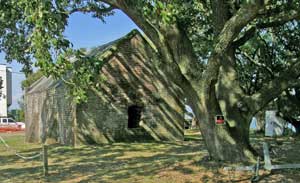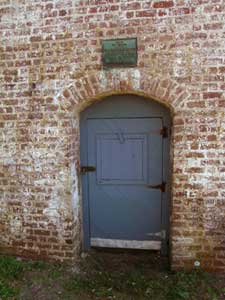Marine Resources Center
The History of Fort Johnson
 No traces now exist of the original Fort Johnson which stood at Windmill Point on James Island. This fort was constructed about 1708 and was named after the Proprietary Governor of the Carolinas, Sir Nathaniel Johnson. A second fort was built in 1759 and portions of its "tabby" walls, made from sea shells, are still visible today. In 1775, this fort was occupied by three companies of South Carolina troops under Lt. Col. Motte. During the American Revolution, the fort remained in colonial hands until 1780 when British forces advancing on Charleston found it abandoned. A siege map of the period shows it as destroyed, but whether by enemy action or by storm has not been determined. A third fort, built in 1793, was abandoned temporarily in 1800 after a storm breached its sea wall. Some work apparently was done during the War of 1812, but another storm in 1813 almost destroyed the fort. By 1827, scarcely a vestige remained.
No traces now exist of the original Fort Johnson which stood at Windmill Point on James Island. This fort was constructed about 1708 and was named after the Proprietary Governor of the Carolinas, Sir Nathaniel Johnson. A second fort was built in 1759 and portions of its "tabby" walls, made from sea shells, are still visible today. In 1775, this fort was occupied by three companies of South Carolina troops under Lt. Col. Motte. During the American Revolution, the fort remained in colonial hands until 1780 when British forces advancing on Charleston found it abandoned. A siege map of the period shows it as destroyed, but whether by enemy action or by storm has not been determined. A third fort, built in 1793, was abandoned temporarily in 1800 after a storm breached its sea wall. Some work apparently was done during the War of 1812, but another storm in 1813 almost destroyed the fort. By 1827, scarcely a vestige remained.
About this time the fort was dropped from reports of United States fortifications, although between 1820 and 1830 a free-standing brick magazine was constructed on the eastern side of the reservation as was an armed martello tower on the western side. The wooden interior of this tower was burned in 1859. By 1864, all except the tower foundation had been destroyed. The magazine is still intact and in excellent condition.
During early 1861, South Carolina state troops erected two 10-inch mortar batteries of two mortars each and an earthwork of three guns. The signal shot which opened the bombardment of Fort Sumter and marked the beginning of the American Civil War was fired from the east mortar battery on April 12, 1861. A historical marker on the Fort Sumter side of the point designates the approximate site of the battery. During the next three years, considerable building activity turned Fort Johnson into an entrenched camp mounting 26 guns and mortars. Aside from a certain amount of artillery fire, the only major action at the fort occurred July 3, 1864, when its Confederate defenders, numbering about 130 men, repulsed two Union regiments totaling about 1,000 men. The attacking force, embarking from Morris Island in small boats, sustained 26 casualties and lost 140 men as captives. The Confederate loss was one killed and three wounded. On the night of February 17, 1865, Fort Johnson was evacuated during the general Confederate withdrawal from Charleston Harbor.
 After the Civil War, a quarantine station was operated at the site under joint municipal (City of Charleston) and state control. An agreement in 1906 transferred the property to the federal government, and operations were taken over by the United States Marine Hospital Service. A quarantine facility continued to operate there until the College of Charleston and the Medical College of South Carolina received title to the property in the 1950's. During this period, the Marshlands House, a structure of historical and architectural importance, was relocated to the Fort Johnson site. The house was originally constructed about 1810 on the Cooper River at the site of the present United States Naval Base. By 1961, the Navy intended to demolish it to make room for a new dry dock. Through the efforts of Dr. G.D. Grice and others, funds for relocation to Fort Johnson were raised. The house was barged to its present location in December, 1961.
After the Civil War, a quarantine station was operated at the site under joint municipal (City of Charleston) and state control. An agreement in 1906 transferred the property to the federal government, and operations were taken over by the United States Marine Hospital Service. A quarantine facility continued to operate there until the College of Charleston and the Medical College of South Carolina received title to the property in the 1950's. During this period, the Marshlands House, a structure of historical and architectural importance, was relocated to the Fort Johnson site. The house was originally constructed about 1810 on the Cooper River at the site of the present United States Naval Base. By 1961, the Navy intended to demolish it to make room for a new dry dock. Through the efforts of Dr. G.D. Grice and others, funds for relocation to Fort Johnson were raised. The house was barged to its present location in December, 1961.
The majority of the Fort Johnson property was transferred to the S.C. Wildlife and Marine Resources Department in 1970. A small portion of land was retained by the College of Charleston for the Grice Marine Laboratory, which is currently used as a teaching and research facility. The Medical University, the successor to the Medical College, kept title to a large dwelling on the northwestern point.
